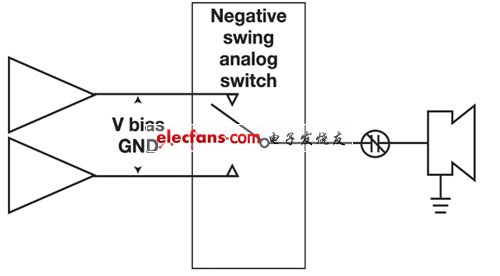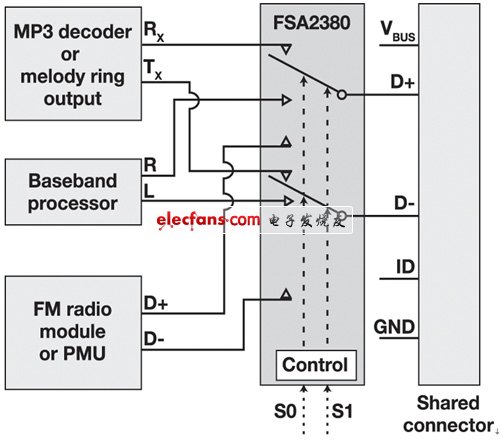Traditionally, designers of portable products have almost relied on standard amplifiers with output bias set at Vcc / 2. This configuration is very suitable for use with standard analog switches, the signal will not be clipped when passing through, and can maintain high audio performance. Place an AC coupling capacitor between the switch and the speaker to remove the DC bias voltage on the audio signal.
The use of a new low-power, Class D, zero-bias output audio amplifier / negative-swing switch combination eliminates the need for AC coupling capacitors, which allows designers to obtain many system benefits while also providing a larger speaker Power requirements. These benefits include lower cost, less board space, simplified bill of materials, and the elimination of the main source of "POP" noise.
Advantages of negative swing systems
In AC-coupled systems, "POP" noise may be generated when switching from one sound source to another, or during amplifier power-up. Because the POP noise is generated when the capacitor voltage changes suddenly, a low-impedance channel should be used, and current must be allowed to pass before the charge on the capacitor reaches a stable state. At the moment of capacitor charging, current spikes will appear on the speaker, causing "POP" noise. One of the main advantages of the negative swing system is that it can significantly reduce the "POP" noise and clicks associated with the routing of audio signal lines.
Negative swing analog switches can mitigate "POP" noise in the following ways. The first and most important way is to remove the AC coupling capacitor. Figure 1 shows the traditional Vcc / 2 bias audio channel using analog switches. Here, an AC coupling capacitor is needed to change the bias of the audio signal from Vcc / 2 to zero volts before it reaches the speaker. This kind of application is very common, which makes it easy for a single speaker to share the composite sound source in the device.

Figure 1: Standard Vcc / 2 bias audio channel with AC coupling capacitors.
The second common application is to use the bidirectional nature of analog switches to enable a single amplifier to drive multiple speakers. By connecting the audio source to the common port, the switch can be used to transmit audio signals between two output speakers in different modes (such as headphones and hands-free mode).
Figure 2 shows the same system configuration using a negative-swing audio amplifier and a negative-swing analog switch. Because the audio output of the amplifier is already biased at zero volts, no AC coupling capacitors are needed. Analog switches can pass negative input signals, so there is no need to change the output bias of the amplifier to prevent clipping. Removing the AC coupling capacitor eliminates the capacitor charge and discharge effects and the current spikes that produce POP noise, thereby effectively eliminating the main source of POP noise in the audio system.

Figure 2: Negative swing audio system without AC coupling capacitors.
Removal of the coupling capacitor not only improves audio performance and quality, but also saves space on the circuit board (coupling capacitors are generally larger in size, and the values ​​are mostly between 100 and 20 μF). In addition to the negative polarity signal, some analog switches also have built-in termination resistors on unused ports, which further enhances the noise suppression performance of the product by releasing the charge accumulation caused by parasitic lines on the unselected ports or board capacitance.
Removing the capacitor is the main factor to reduce noise, and increasing the embedded termination resistance also helps to enhance the POP noise suppression performance. In addition to the pure audio applications mentioned above, the negative swing characteristic can also improve the design performance of multiple signal sharing.
The FSA2380 shown in Figure 3 is used to switch between full-speed USB, audio, and UART data. Because these switches can be powered by a standard power supply referenced to ground, they can not only handle negative swing audio signals, but also standard signals referenced to ground / Vcc / 2. This function makes this type of product very versatile, and designers can easily realize that different types of signals share a common port.

Figure 3: The analog switch FSA2380 with negative swing performance can multiplex multiple signals.
The second advantage of negative swing audio systems is that they allow designers to increase the voltage swing of the audio path within a specific supply voltage range. Since the system power supply is often limited to the maximum voltage that the battery can provide, the variation margin when using a standard audio signal biased by Vcc / 2 is very small. Negative swing amplifiers often use an internal charge pump, which can double the output range of the amplifier and set the center point of the swing to zero volts.
For example, in a standard Vcc / 2 bias system, the output signal amplitude must be between zero volts and Vcc. However, in a zero-volt bias system, the peak-to-peak output amplitude can be effectively improved. System designers can easily transmit a zero-volt bias signal to a shared speaker using an analog switch with negative swing performance. Can provide greater volume. The audio signal amplitude can exceed the maximum battery voltage by up to 1V, with a total swing of 5.25V.
An important feature to consider when selecting a negative swing analog switch is the device's ability to pass negative voltages when using a single-ended power supply referenced to ground. For example, switches such as the negative swing device provided by Fairchild Semiconductor are optimized for low power (typically less than 1μA) and do not include a charge pump, which can significantly save system power, which is Words are very important.
A zipper Braided Sleeve is a protective covering made from a combination of zipper and braided materials. It is designed to enclose and protect cables, wires, hoses, or any other items that need to be organized and shielded from external elements.
The zipper feature allows for easy access to the contents inside the sleeve, making it convenient for installation, maintenance, or repairs. The braided material provides durability, flexibility, and resistance to abrasion, heat, chemicals, and UV rays.
Zipper braided sleeves are commonly used in various industries, including automotive, electronics, aerospace, and entertainment. They can be used to organize and protect cables in computer systems, audio/video equipment, automotive wiring harnesses, and industrial machinery.
Overall, zipper braided sleeves offer a practical and efficient solution for cable management and protection, ensuring the longevity and reliability of the enclosed components.
Zipper Braided Sleeve,Zipper Sleeve Cable,Wire Protector Cable,Zippper Braided Cable
Dongguan Liansi Electronics Co.,Ltd , https://www.liansisleeve.com
